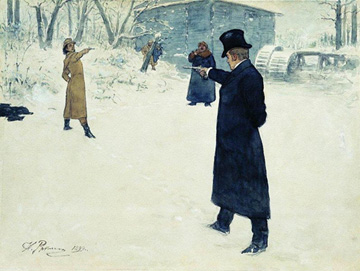

 The Accurate Reloading Forums
The Accurate Reloading Forums  THE ACCURATE RELOADING.COM FORUMS
THE ACCURATE RELOADING.COM FORUMS  Guns, Politics, Gunsmithing & Reloading
Guns, Politics, Gunsmithing & Reloading  The Political Forum
The Political Forum  How much does the GOP hate lower income Americans?
How much does the GOP hate lower income Americans?Go  | New  | Find  | Notify  | Tools  | Reply  |  |
| one of us |
It's spelled out plain as day in Trump's "Big Beautiful Bill." The ugly truth about Trump's "big, beautiful bill" Judd Legum May 19 READ IN APP President Donald Trump greets troops at the Al-Udeid air base southwest of Doha on May 15, 2025. (Photo by Brendan SMIALOWSKI / AFP) On the campaign trail in 2024, Trump pledged to improve the economic conditions of the working class. "My plan will massively cut taxes for workers," Trump declared at a campaign stop in Raleigh, North Carolina, on November 5, 2024, the day before the election. According to Kevin Hassett, the director of the White House National Economic Council, Trump directed Republican lawmakers to "go after the things that are going to help middle-class folks." Trump's economic plans are now codified in the Republican reconciliation bill, which Trump calls his "one big, beautiful bill." Trump is urging Congress to approve it quickly. Trump's bill does cut taxes. But hose tax cuts are partially offset by steep cuts to healthcare programs and the social safety net. How does the combination of these policies impact the typical worker? The non-partisan Penn Wharton Budget Model provided the first comprehensive analysis last Friday. The Penn Wharton Budget Model finds that people who make less than $51,000 will see their after-tax income decrease if Trump's "big, beautiful bill" becomes law. Meanwhile, the top 0.1% will see their income increase by hundreds of thousands of dollars. In 2026, for example, the bottom quintile of earners ($17,000 or less) will see their after-tax income go down by $1,035. Meanwhile, the top 0.1% ($4.3 million or more) will see their after-tax income go up by $389,280. Distributional Effects of the Dollar change in after-tax income in 2026, by income level Over time, the impact on working-class Americans gets worse. By 2030, those in the bottom quintile will see their after-tax income reduced by $1,405. In essence, Republicans are offsetting huge tax cuts for the wealthy by raising taxes on the poor. For example, the bill makes it harder for many Americans to qualify for tax credits that make health insurance more affordable. The bill also slashes billions from programs that provide transfer income to the working class and poor, including housing subsidies, the Supplemental Nutrition Assistance Program (SNAP), and the Low-Income Home Energy Assistance Program (LIHEAP). The analysis also highlights that the policies touted by Trump on the campaign trail as a boon to the working class have a relatively small impact. For example, the bill eliminates taxes on tips for many workers until 2028. But many workers in tipped professions already do not earn enough to pay federal income taxes. It also temporarily eliminates taxes on overtime pay. But many workers do not receive overtime pay. For those that do, it is often a small percentage of their income. While these policies are popular, they are more than offset by the massive cuts to healthcare subsidies and other aspects of the social safety net. Millions will lose health insurance The issues with the reconciliation bill go beyond a reduction in income for those who can least afford it. According to an analysis by the Congressional Budget Office (CBO), millions of people will lose their health insurance. First, the reconciliation bill would codify a recent rule proposed by the Trump administration that would make it harder to receive coverage through the Affordable Care Act (ACA) marketplace. For example, there is currently an annual enrollment period from November 1 to January 15. The bill would shorten the open enrollment period by one month, making it more difficult for people to apply. Those and other changes in the rule would "increase the number of uninsured people by 1.8 million by the year 2034." Second, the bill attempts to slash spending on Medicaid. It imposes work requirements that will eliminate coverage for people unable to find work or who fail to provide proof of employment. The bill "would require states to deny coverage to people applying for Medicaid if they are not already working (or participating in another qualifying activity) at least 80 hours per month, as well as terminate Medicaid for people already enrolled if they cannot document that they are meeting work requirements." There are exemptions for "caregivers of dependent children, people with disabilities, people who are pregnant" and a few other groups. While this sounds straightforward, in practice, similar policies implemented at the state level have mostly excluded "people who work or should qualify for an exemption but nevertheless would lose coverage due to red tape." It would reduce Medicaid matching funds for any states that cover immigrants with state funds, even immigrants who are in the country legally. And it would impose a variety of new bureaucratic requirements for people to prove that they are eligible for Medicaid. All told, these changes would "increase the number of people without health insurance by at least 7.7 million in 2034." Finally, as part of the Inflation Reduction Act, the Biden administration extended enhanced premium credits under the ACA that were initially put into place during the pandemic. The reconciliation bill allows those credits to expire at the end of the year, a policy that the CBO projects will result in 4.2 million more uninsured people by 2034. The exploding deficit The cuts to health insurance and the social safety net are intended to blunt the fiscal impact of Trump's tax cuts for the wealthy. But the tax cuts are so large that the reconciliation bill would explode the deficit anyway. According to the Committee for a Responsible Federal Budget, the reconciliation bill would "add roughly $3.3 trillion to the debt through Fiscal Year (FY) 2034." Notably, the Committee for a Responsible Federal Budget does not find that spending cuts by DOGE will reduce future budget deficits because DOGE has not meaningfully reduced federal spending. There is hope, even when your brain tells you there isn’t. – John Green, author | ||
|
| One of Us |
Sounds about like what I would expect from Trump, step on the fingers of those struggling to climb the ladder of life while giving a huge gift to the wealthiest Americans. Christian my ass. | |||
|
| Administrator |
| |||
|
| one of us |
The party doesn't any more hate low-income voters than coyotes hate bunnies. Coyotes eat bunnies, Republicans hire low skilled employees for peanuts. TomP Our country, right or wrong. When right, to be kept right, when wrong to be put right. Carl Schurz (1829 - 1906) | |||
|
| Moderator |
Oh fun... would you says Apple is a GOP company? I don't see anti suicide nets outside us factories and office buildings, like the do at Foxconn, where they build iphones with near slave labor opinions vary band of bubbas and STC hunting Club Information on Ammoguide about the416AR, 458AR, 470AR, 500AR What is an AR round? Case Drawings 416-458-470AR and 500AR. 476AR, http://www.weaponsmith.com | |||
|
| one of us |
If there is a clever retort to this post, it's beyond my poor thinking. It's damn sad. We have the economic safety net of unemployment and welfare. My knowledge of China's arrangements is lacking. TomP Our country, right or wrong. When right, to be kept right, when wrong to be put right. Carl Schurz (1829 - 1906) | |||
|
| Moderator |
You said gop hires people for peanuts. Nike and apple use slave labor opinions vary band of bubbas and STC hunting Club Information on Ammoguide about the416AR, 458AR, 470AR, 500AR What is an AR round? Case Drawings 416-458-470AR and 500AR. 476AR, http://www.weaponsmith.com | |||
|
| One of Us |
GOP is in business of employing people? Never been lost, just confused here and there for month or two | |||
|
| One of Us |
Yes, the GOP hires folks to do office work and telephone calls. I remember seeing one of them as a patient. I commented on it as I saw the name on the insurance line… “I took a job there. I don’t believe anything they say or do! I’m a democrat voter!” | |||
|
| One of Us |
9 of the 10 poorest states are red states. 95 out of 100 of the poorest counties are red counties. The GOP has worked so well for them. | |||
|
| One of Us |
And yet the morons there continue to vote GOP. | |||
|
| One of Us |
Where has Democrat policy helped the most? California? Minnesota? How would Dem policy, if there is one, help the folks of Mississippi? Legal drug use? Camping in city park? Allow kids to amputate body parts? Trapping restrictions? How bout gun policy?What specific Democrat policy would benefit poor red states the most? | |||
|
| One of Us |
And yet the generational welfare rats in every major city continue to vote dimp. Coincidence? ~Ann  | |||
|
| One of Us |
Actually, I'm not that sure that either one of those groups are reliable voters for either party. In fact, I'd guess that most of them don't vote at all. | |||
|
| One of Us |
Only kids who trap should be allowed to amputate body parts....and then, only if they camp in a city park. Which brings to mind the question: does Dem policy allow trapping in city parks? Or can you only do that if you have amputated a body part? | |||
|
| One of Us |
And yet there are morons in Couer d' Alene Idaho. Old Corps Semper Fi FJB | |||
|
| One of Us |
Lot of questions there. But Minnesota and California are much better off financially than the poorest counties, mainly in the south. Look at where the GOP policies have left them. Could the Dems do worse? | |||
|
| One of Us |
Right about now, I would say that the dems would have FEMA at work in Missouri, Kentucky, Ark, etc. Or at least acknowledged the disasters. GOP awfully quiet on that after falsely bashing Biden over FEMA. I've not even seen a single word of sympathy or condolence from trump. Too busy with his multi million dollar golf shit. That's how much the GOP thinks of people in need. | |||
|
| One of Us |
Yes, there are many morons in CDA. This area went for Trump. We have plenty of morons already, so don't apply. | |||
|
| Powered by Social Strata |
| Please Wait. Your request is being processed... |
|
 The Accurate Reloading Forums
The Accurate Reloading Forums  THE ACCURATE RELOADING.COM FORUMS
THE ACCURATE RELOADING.COM FORUMS  Guns, Politics, Gunsmithing & Reloading
Guns, Politics, Gunsmithing & Reloading  The Political Forum
The Political Forum  How much does the GOP hate lower income Americans?
How much does the GOP hate lower income Americans?

Visit our on-line store for AR Memorabilia

